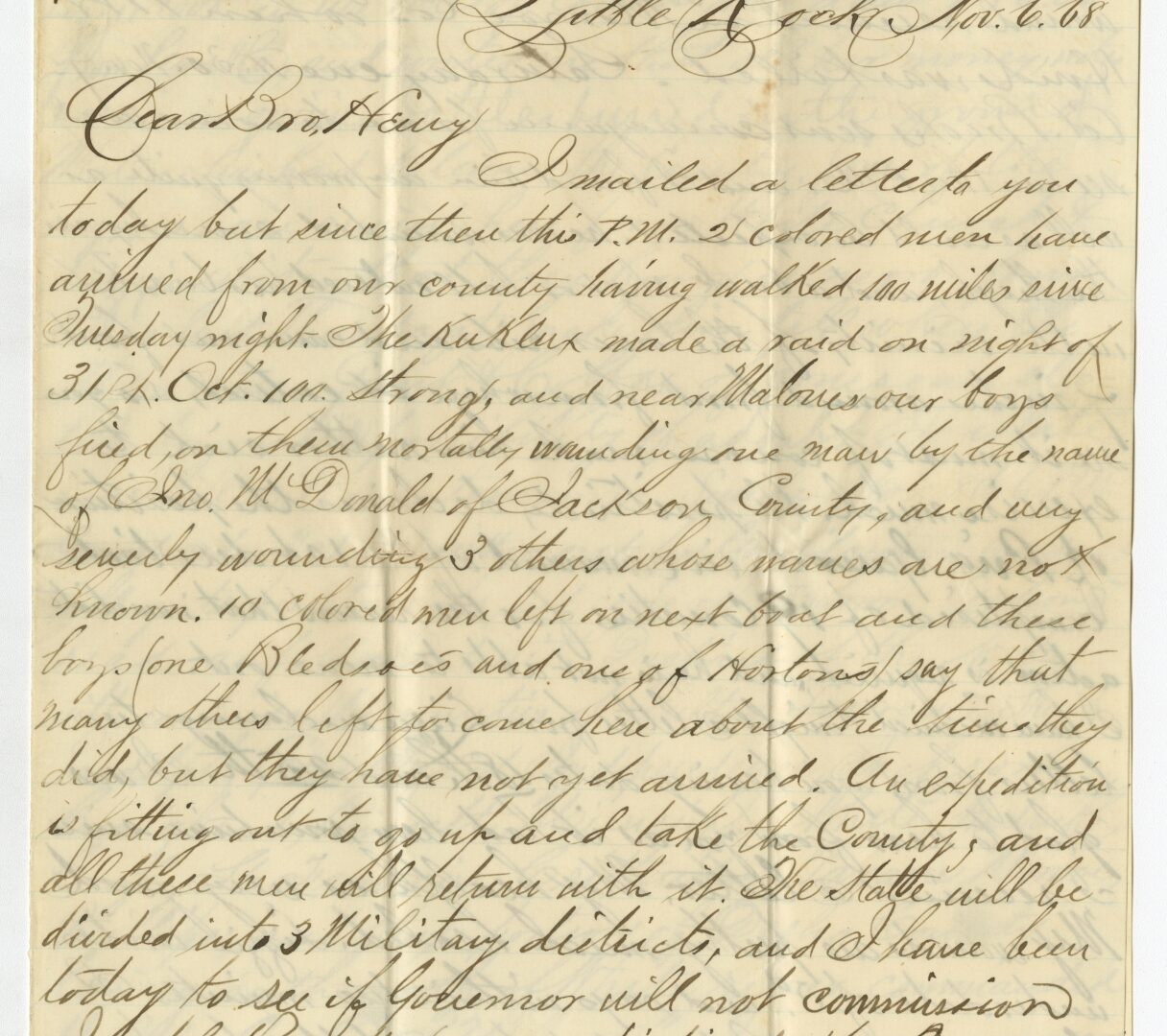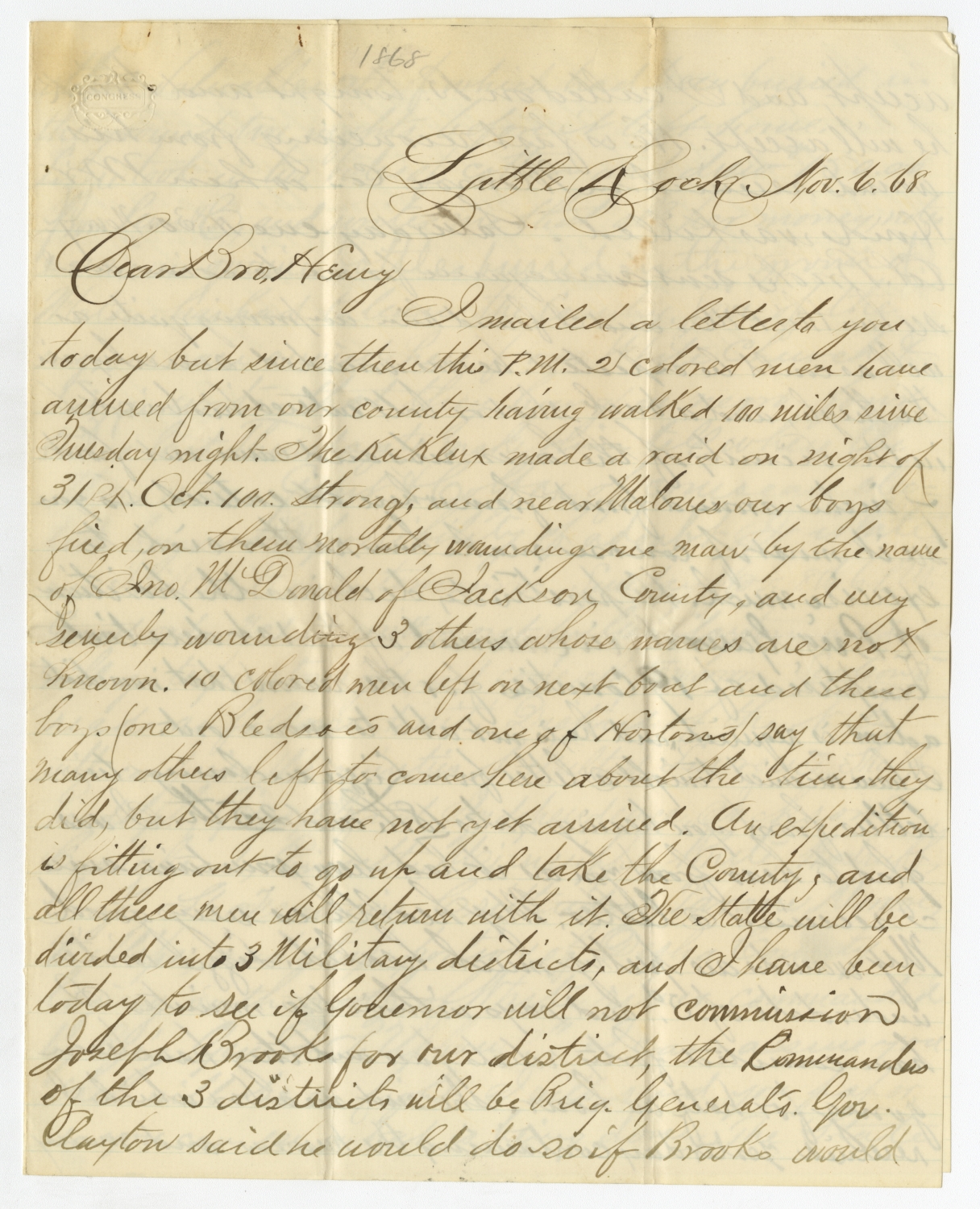"There Will Be a Fight:” Arkansas After the Civil War
Introduction
Although the Civil War officially ended in 1865, tensions, conflicts, and fighting were not over for years and even decades afterward. In Arkansas, shortly after the war, Radical Republicans, who advocated voting rights for African American men and restrictions against former Confederates’ voting rights, clashed with former Confederates and their sympathizers. The latter group opposed civil rights for African Americans and was determined to protect the racial privileges of white men, especially those who supported the Confederacy.
After the new state constitution of 1868 was ratified and Powell Clayton, a former Democrat but now one of the co-founders of the Republican Party in Arkansas, was elected to serve as Arkansas governor, former Confederates and their sympathizers were furious. Among many provisions, the new constitution declared racial discrimination illegal, and Clayton enjoyed the support of Radical Republicans.
In April 1868, only one month after black Arkansas men voted for the first time, the Ku Klux Klan emerged and became active in Arkansas. Across the state, the Klan terrorized black Arkansans and white Republicans. In July 1868, the state legislature approved the creation of a state guard and reserve armed groups. Governor Clayton ordered several counties to create and prepare armed military-style forces. Their task was to stop the Klan and protect the rights of newly freed African Americans as well as the safety of Republicans and their supporters. In several counties, tensions between those local military forces and the Klan got so severe that Governor Clayton declared martial law in those areas and divided the state into four military districts. Historians refer to the conflicts that erupted across the state in the aftermath of the ratification of the 1868 Constitution as Militia Wars of 1868–1869.
Governor Clayton selected Daniel Phillips Upham from Woodroof Country to command the northeast military district. In this activity, you will examine a letter that Upham wrote to his brother Henry between November 6 and November 8, 1868. In it, Upham discusses the ongoing violence against African Americans and white Republicans.
*Important vocabulary note: The document used in this activity, includes the term “negro” to refer to an African American. Today, this term is considered offensive and disrespectful. Until the 1960s, however, it was used as a descriptive (neutral or non-offensive) term that both black and white Americans used to refer to African Americans. Historical documents often include words that we consider offensive and disrespectful today. It is important that we study how language changes and remember that words, just like actions, are often used to harm or belittle individuals or entire groups. History helps us understand why words matter.
Activity Questions
D. P. Upham letters to Henry Upham, page 1
- Before you analyze this document, see “Important vocabulary note” in “Introduction” for additional information on the use of the term “negro” in this primary source.
- Where and when was this letter written? Note that the author’s letter wrote this letter over the course of several days, the dates of which he marks in the letter. Who wrote it and to whom is it addressed?
- Read the Encyclopedia of Arkansas article about Daniel Phillips Upham: https://encyclopediaofarkansas.net/entries/daniel-phillips-upham-1790/. Who was he?
- What happened since Upham last wrote to his brother?
- What happened on the night of October 31?
- Upham writes that African American men (at least 10) were leaving the site of the Ku Klux Klan raid to join his forces in Little Rock. Why do you think they did that?
- Upham informs his brother that Arkansas will be divided into three military districts. Upham hopes a man named Col. Brooks becomes one district’s commander but Brooks declines to accept the position. Why does he decline? What does Brooks’ refusal tell us about the South three years after the formal end of the Civil War?
- What do we learn about Upham’s health from this letter? What does this information tell us about what he experienced recently?
- Who are the rebels that Upham learns about from Lizzie’s letter? What does Lizzie tell him about them?
- What does Section 5 of Order No. 1 say?
- What are Upham’s predictions for the near future?
- What does this letter tell us about Arkansas three years after the end of the Civil War? What post-war issues and challenges does this letter discuss?
- How could Upham’s point of view (his beliefs, political views, experience, etc.) shape his understanding of the situation around him? Provide specific examples of his point of view from the letter.
Primary Sources
To learn more about the primary sources featured in the activities above, click the following links:
Arkansas Social Studies Standards
Social Studies (US History 1800-1900), Grades 8
- Strand: Era 5: Civil War and Reconstruction 1850-1877
- Content Standard 2: Students will analyze the American Civil War and Reconstruction and their effects on the social, economic, and political development of America.
- Era5.2.8.3 Analyze social and economic effects of the Civil War on America
- Era5.2.8.5 Evaluate the legacy of the Civil War on the nation
- Era5.2.8.6 Evaluate successes and failures of Reconstruction
African American History, Grades 9 -12
- Strand: A Country Divided 1820-1877
- Content Standard 3: Students will compare and contrast the development of the northern, western, and southern regions of the United States and the effects on African American men and women.
- CD.3.AAH.2 Examine regional perspectives toward the political rights of African American men and women between 1820 and 1877
- CD.3.AAH.3 Analyze the responses of free and enslaved African American men and women to regional social, economic, and political conditions during the Civil War and Reconstruction Era
Arkansas History, Grades 7 – 8
- Strand: History
- Content Standard 7: Students will examine the impact of historical events and people on the development of Arkansas
- H.7.AH.7-8.4 Examine effects of Reconstruction in Arkansas using multiple, relevant historical sources
Arkansas History, Grades 9 – 12
- Strand: Era 3: Civil War Through the Gilded Age 1861-1900
- Content Standard 3: Students will analyze factors that influenced the perspectives of Arkansans from the Civil War through the Gilded Age.
- Era3.3.AH.9-12.2 Research social, economic, and political effects of the Civil War on citizens in various regions from multiple perspectives
- Era3.3.AH.9-12.4 Examine effects of Reconstruction in Arkansas using multiple, relevant historical sources
Key Terms
More Information
- https://encyclopediaofarkansas.net/entries/daniel-phillips-upham-1790/
- https://encyclopediaofarkansas.net/entries/militia-wars-of-1868-1869-7904/
- https://encyclopediaofarkansas.net/entries/civil-war-through-reconstruction-1861-through-1874-388/
- https://encyclopediaofarkansas.net/entries/ku-klux-klan-2293/
Downloadable Guides and Handouts
We encourage K-12 educators to use History Alive: Virtually! in a way that will best match their classroom needs. The “Exercise” handout includes a complete exercise as featured on this website, the “Primary Sources” handout includes only primary sources used in the exercise, and the “Questions” handout includes analytical questions from the exercise but is editable and can be easily changed to best match students’ needs.
“There Will Be a Fight:” Arkansas After the Civil War – Exercises
“There Will Be a Fight:” Arkansas After the Civil War – Primary Sources
“There Will Be a Fight:” Arkansas After the Civil War – Questions


